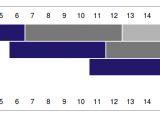A while ago, Mozilla announced that it will chaining its development process for Firefox to enable faster releases. Google released roughly eight major versions of Chrome in the time it took Mozilla to build Firefox 4. Now that Firefox 4 is less than a week away, Mozilla has provided a draft proposal of the new, schedule-driven process.
Mozilla plans to release a new major version once every six weeks once the process stabilizes. What's more, it will maintain three branches in parallel ranging from experimental to stable.
Every six weeks, a Firefox build is graduated from a more experimental branch to a more stable one. Any features that are not ready are pulled out and deferred to future releases.
Google Chrome served as the inspiration
If all of this sounds very familiar it's because that's exactly what Google does with Chrome. Some might find that Firefox 4 borrows quite a lot from Google Chrome and it seems that Mozilla is only getting started.
But there's no shame in it, if one method works better than another, it gets picked, that's the way open-source software is built. In fact, Mozilla even got help from Google in creating its new schedule, notably from Chrome program manager, Anthony LaForge.
The six weeks release cycle
The new process is still a proposal. While Mozilla wants to implement it as soon as possible, there are unforeseeable circumstances.
But if things go smoothly, Firefox 5 will be landing in 16 weeks and Firefox 6 six weeks after that.
There are several big changes to the way development for Firefox will be carried out from now on. All active development, new features, patches, changes and so on, will happen in mozilla-central - the nightly builds. This is the equivalent of the Chromium nightly builds.
After six weeks, all mozilla-central code is ported to the Firefox experimental branch. This is the equivalent of Google Chrome dev. In this channel, existing features will be polished and fixed.
No new features will be added and anything that doesn't work is 'turned off.' To ensure that experimental features don't ruin the experience for users, they should be easly disabled and allowed only on demand.
Six weeks later, the build moves to the Firefox beta channel where stability is the main concern. Again, features that don't work can be easily turned off.
Finally, six weeks after that, a new Firefox stable version is released. Any feature that hasn't been finalized is removed.
Automatic silent updates
In order to make this work, Mozilla has to make several big changes. One of the most obvious is a new automatic, silent update system. This ensures that users are always running the latest version of the channel they're using.
Another change is that older versions will no longer be supported with security updates. Because of the automatic updates, this should be less of an issue.
If everything goes smoothly, there should be a Firefox 7 release by the end of the year. Don't hold your breath though, things rarely go smoothly at Mozilla. That said, once the system is up and running, Firefox users will be enjoying new features faster while also not having to hassle with updates.

 14 DAY TRIAL //
14 DAY TRIAL // 
